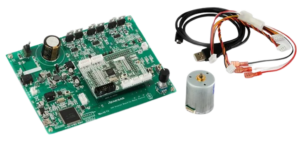Motor Control
Used for measuring the current in motors, this technology helps monitor and control the motor's operational state, thus enhancing the efficiency and reliability of the motor system. Here are some key applications of current sensor chips in motor control:
Motor Drive Control: Typically integrated into the motor power circuit, this monitors current changes to provide real-time insights into the motor’s operating status. The control system can use this current data to adjust the motor's speed and torque for precise motor drive control.
Overload Protection: Detects when the motor current exceeds a predefined threshold, indicating potential overload conditions. Upon detecting an overload, the control system can promptly take actions such as reducing the load or cutting off the power to prevent motor damage.
Fault Detection: Monitors the motor's current waveform to identify anomalies like bearing faults or phase loss. Early detection of faults allows for preventive maintenance, reducing the risk of severe issues during motor operation.
Energy Consumption Monitoring: Real-time monitoring of current changes enables calculation of the motor's power consumption, facilitating effective energy monitoring and management. This is essential for energy management and optimization in industrial settings.
Closed-Loop Control: Often used as a feedback sensor in motor control systems, providing actual current data for closed-loop control. In such systems, the controller adjusts the motor’s output based on the discrepancy between actual and target current, ensuring more accurate control.

Advantages:
Precise Measurement: Accurately measures current in the motor, which is essential for motor control. Real-time measurement ensures effective monitoring and control of the motor’s operational state, thereby enhancing the stability and performance of the motor system.
Current Protection: Monitors overload or fault currents in the motor and provides timely feedback to the control system. This allows for prompt motor shutdown in case of anomalies, preventing damage to the motor or other equipment and ensuring safe system operation.
Space and Cost Efficiency: Compared to traditional current measurement methods, current sensor chips are generally compact, easy to install, and require no additional external components. This saves system space and reduces costs, which is particularly important in space-constrained and highly integrated applications.
Digital Interface: Many current sensor chips feature digital interfaces (such as I2C, SPI, etc.) for direct connection to digital controllers or microprocessors, enabling high-speed data transfer and processing. This contributes to greater intelligence and automation in the control system.
Programmability: Some current sensor chips offer programmable features that allow flexible configuration and adjustment to meet specific application needs. This enables motor control systems to accommodate various motor types and operating conditions, enhancing flexibility and adaptability.
Current sensor chips facilitate precise motor drive, protection, and fault detection, improving the performance and reliability of the motor system. When selecting and applying current sensor chips, factors such as current range, accuracy, and response time should be considered to meet the specific requirements of the motor control system.
